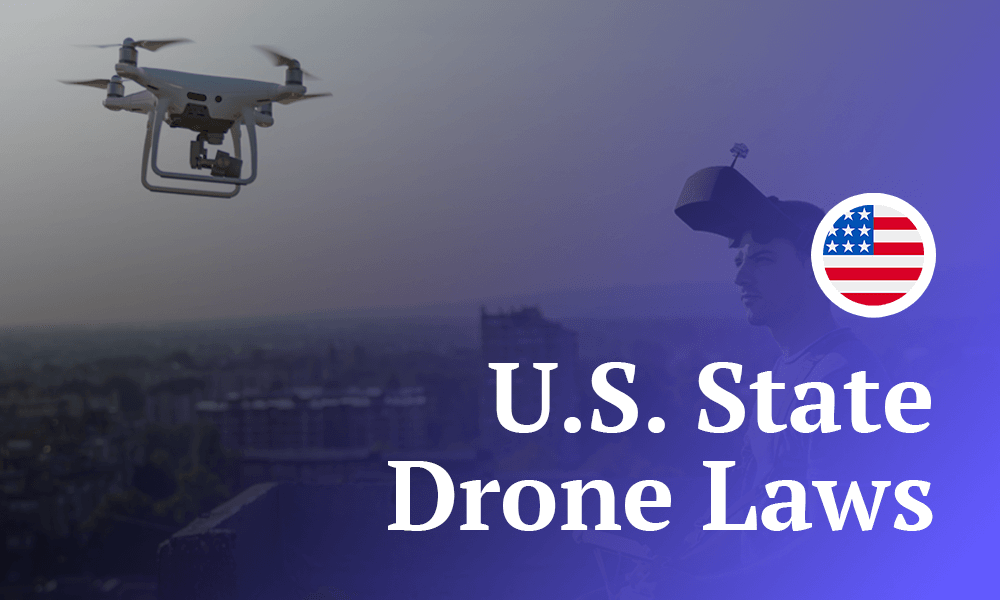
US Drone Laws: What Are the State and Federal Regulations in 2025?
Quick Summary: U.S. Drone Laws
To legally use a drone in the U.S., you must register it at faadronezone-access.faa.gov and display the registration number on the body of the drone. You may not fly a drone above 400 feet, out of your line of sight or near an air traffic control tower without special permission.
A drone is an aerial vehicle without any human crew aboard. First broadly employed in the Vietnam War, drones are now used for everything from fighting fires to spying on neighbors to annoying strangers at the park. If you plan to operate a drone yourself, start by getting familiar with drone laws.
Since drones became widely available for civilian use, both the federal government and individual states have passed laws governing how drone pilots can use them. It makes sense. You can do a lot of shady things with total control of a hovercraft, even if you aren’t personally on board.
Even so, some drone laws in the U.S. go further than you might anticipate. In this article, I’ll give you the full scoop on every drone regulation that applies to the whole country, and a few important state laws. So grab your remote controller and rev up your propellers — it’s time for a flyover of U.S. drone laws.
Can I Fly My Drone Around My Neighborhood?
Yes, as long as it’s registered, you can see it and it remains below 400 feet. Also, if you live in one of the 19 states where using a drone to invade someone’s privacy is a crime, don’t fly over anyone else’s property (though you really shouldn’t do that anywhere without permission).Can You Fly a Drone Under 250 Grams Anywhere?
No — controlled and restricted airspace laws still apply to drones weighing less than 0.55 pounds or 250 grams. However, you don’t need to register these drones with the FAA.Do You Need a License to Fly a Drone in the USA?
If you only use the drone for personal entertainment, you don’t need a license — just a certificate of completion for The Recreational UAS Safety Test (TRUST). You will need a license to pilot a drone for any commercial purposes.Can I Fly My Drone at Night 2023?
Yes, and you don’t even need a waiver! However, the drone must have lights visible at all times.What Is the FAA Trust Test?
TRUST stands for The Recreational UAS Safety Test. Passing TRUST is sufficient authorization for using a drone non-commercially. You can take it online.
Drone Laws From the Federal Aviation Administration (FAA)
Drone regulations often refer to a drone by two alternate names: unmanned aerial vehicle (UAV) or unmanned aircraft system (UAS). I’ll be using all three interchangeably.
Drone usage in the United States is governed by the Federal Aviation Administration (FAA), the same government body that regulates manned flight. Certain laws apply differently depending on whether you’re flying your drone recreationally or for a commercial enterprise, but most laws apply to everybody.
For starters, remember the first golden rule of drone usage: manned aircraft have no responsibility to avoid you. Your drone is smaller and harder to see, so staying clear is your job. If a truck runs over your remote-controlled car, it’s your fault for driving it in the street — the same is true in the skies.
Next, learn where you’re allowed to pilot your drone freely, where you’ll need approval from air traffic controllers and where you’re not allowed to fly it at all.
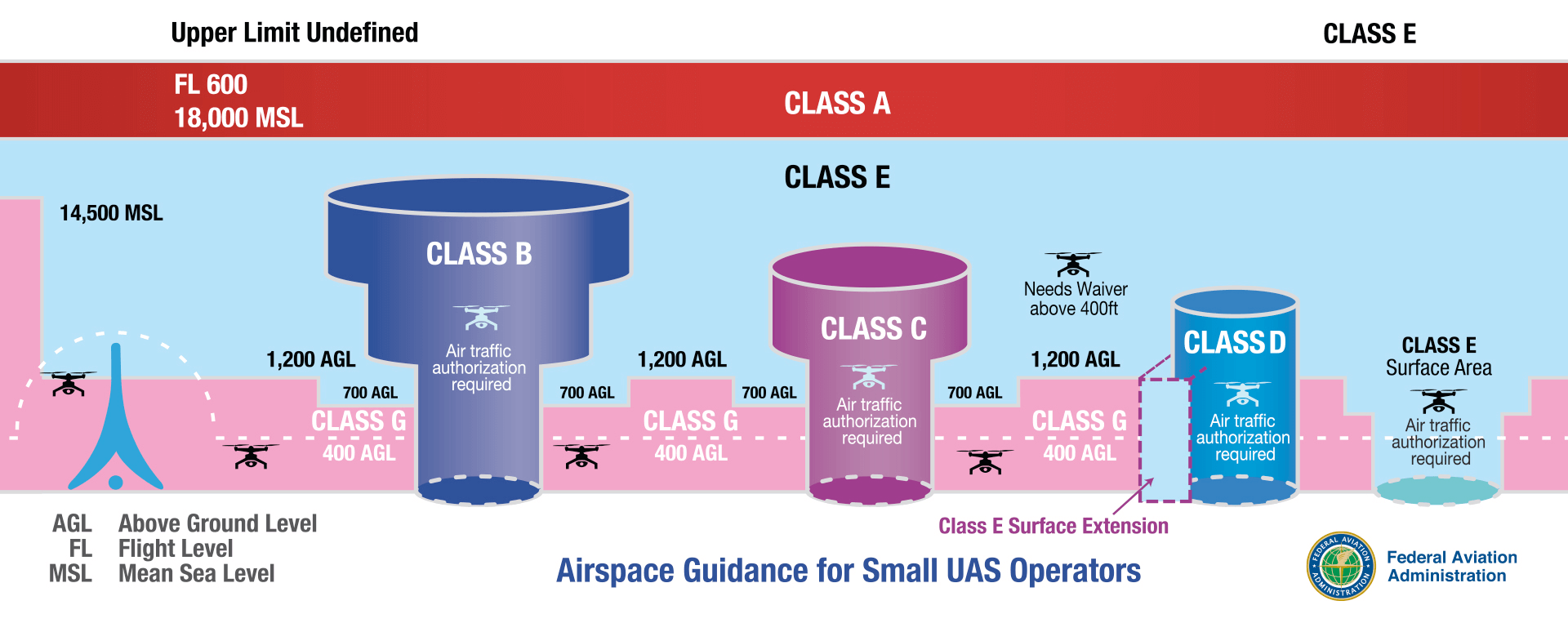
The FAA regulates all airspace within U.S. territory, so it’s all considered regulated airspace. But within the regulated area, there’s controlled and uncontrolled airspace. Controlled airspace is any airspace where air traffic controllers direct all aerial vehicles, such as the vicinities of almost all airports. Everything else is considered uncontrolled.
The second golden rule of drone laws is that, barring local exceptions, you can fly a drone in any uncontrolled airspace below 400 feet. You can often fly a drone in controlled airspace as well, but you must have permission from air traffic control first. In all regulated airspace, 400 feet is the upper limit.
The third golden rule is that if you’re going to fly your UAV at night, it must be equipped with lights visible from at least three miles away.
Exceptions to the 400-Foot Rule
Notice that I said “barring local exceptions.” Exceptions to the 400-foot rule take many forms depending on where you are, but a few apply across the entire country.
You’re not permitted to fly a drone at the site of any disaster that requires aerial operations, such as wildfires and hurricanes. Search-and-rescue vehicles need to have the sky to themselves.
You’re not permitted to fly a drone at the site of any disaster that requires aerial operations, such as wildfires and hurricanes. Search-and-rescue vehicles need to have the sky to themselves.
You can’t fly a drone in any airspace designated as “national security sensitive,” including military installations, power infrastructure (especially nuclear) or national landmarks. That means no drone photos of Mt. Rushmore or the Statue of Liberty. You can find the full map of security-sensitive locations on the FAA website.
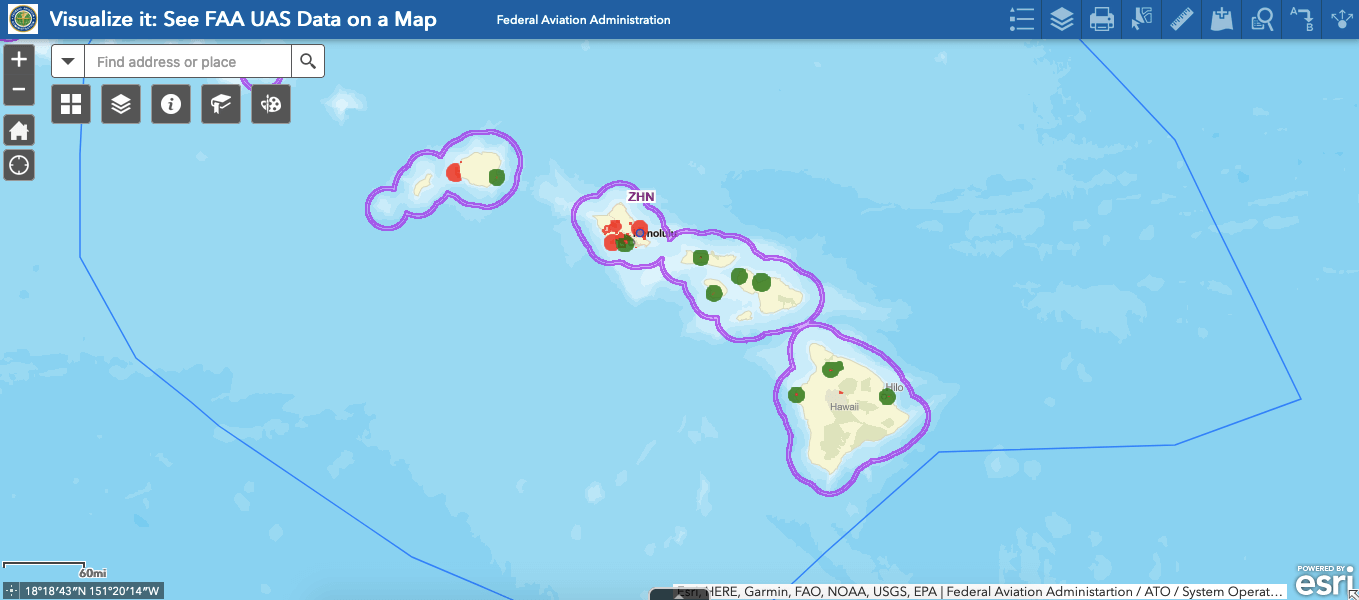
All national parks are strict no-drone zones, to prevent idiots from doing idiot things like dunking their drones into geysers at Yellowstone. Technically, you could launch your drone from outside the park boundaries as long as it doesn’t land in the park, but this would make you a bad person who deserves to have their drone eaten by wolves.
You may not fly a drone within three miles of any athletic stadium that seats more than 30,000 fans, starting an hour before a game and ending an hour after it. This prevents you from using a drone to menace the large open-air crowd or affect the outcome of a game. Let’s face it: some people would dive-bomb the referee if it was legal.
Finally, no drones are allowed within 15 miles of Ronald Reagan Washington National Airport in Washington, D.C. Drones in a further 15-mile radius are also regulated, but if you’re registered and stay below 400 feet, you should be fine.
Laws for Flying Drones Recreationally
Private drone pilots using their UAS for fun can take advantage of some exceptions. You are required to register any drone that weighs more than 0.55 pounds and clearly label it with its registration number (much like a car). You can register through this link.
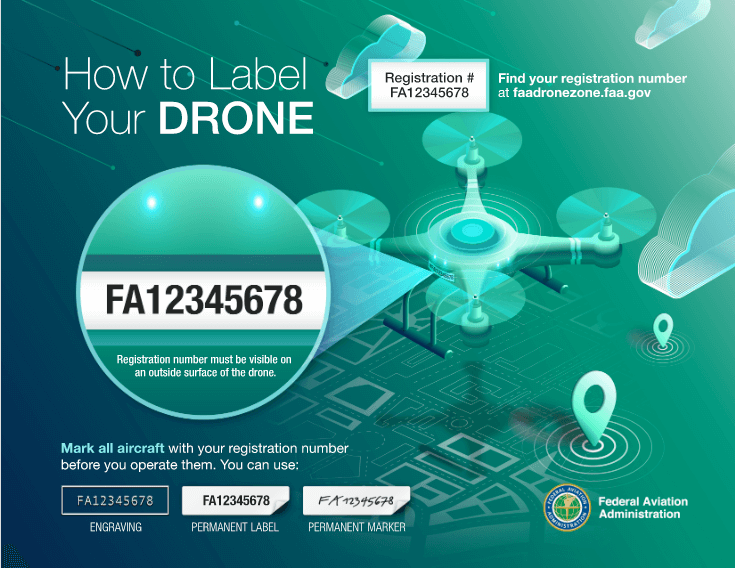
In addition to registering, you must also take The Recreational UAS Safety Test (TRUST). You can take this test online for free through one of several organizations approved by the FAA. Once you pass, print out your certificate and have it on your person at all times when flying your drone.
Your drone must always remain within your line of sight (or, if you’re legally blind, that of a sighted person next to you). Also, unless your drone weighs less than 0.55 pounds and has no moving parts that could injure a person, you cannot fly it above people or moving vehicles.
The final rule is that you must never use your drone “in a manner that endangers the safety of the national airspace system.” This can mean any number of things, but chances are you’ll know if you’re doing it.
One more thing: Starting in September 2023, all drones will be required to broadcast their locations to a remote ID system. Since this law was published in December 2019, most new drones should have remote ID built in, but older models will need to add remote ID transmitters before they can legally fly.
Laws for Commercial Drone Pilots
The FAA defines a non-recreational drone flight as any activity that occurs for profit or on behalf of an organization. If you’re flying drones to get some nice photos for your wall, that’s recreational. If you sell those photos — or even use them in a portfolio to get hired as a photographer — your drone operations are now commercial.
You also don’t have to make money before you’re considered a commercial drone operator. Flying as a volunteer on behalf of a nonprofit still counts, since you’re using the drone for purposes other than your own fun. If you fly the drone for anything other than grins and giggles, the stricter laws apply to you.
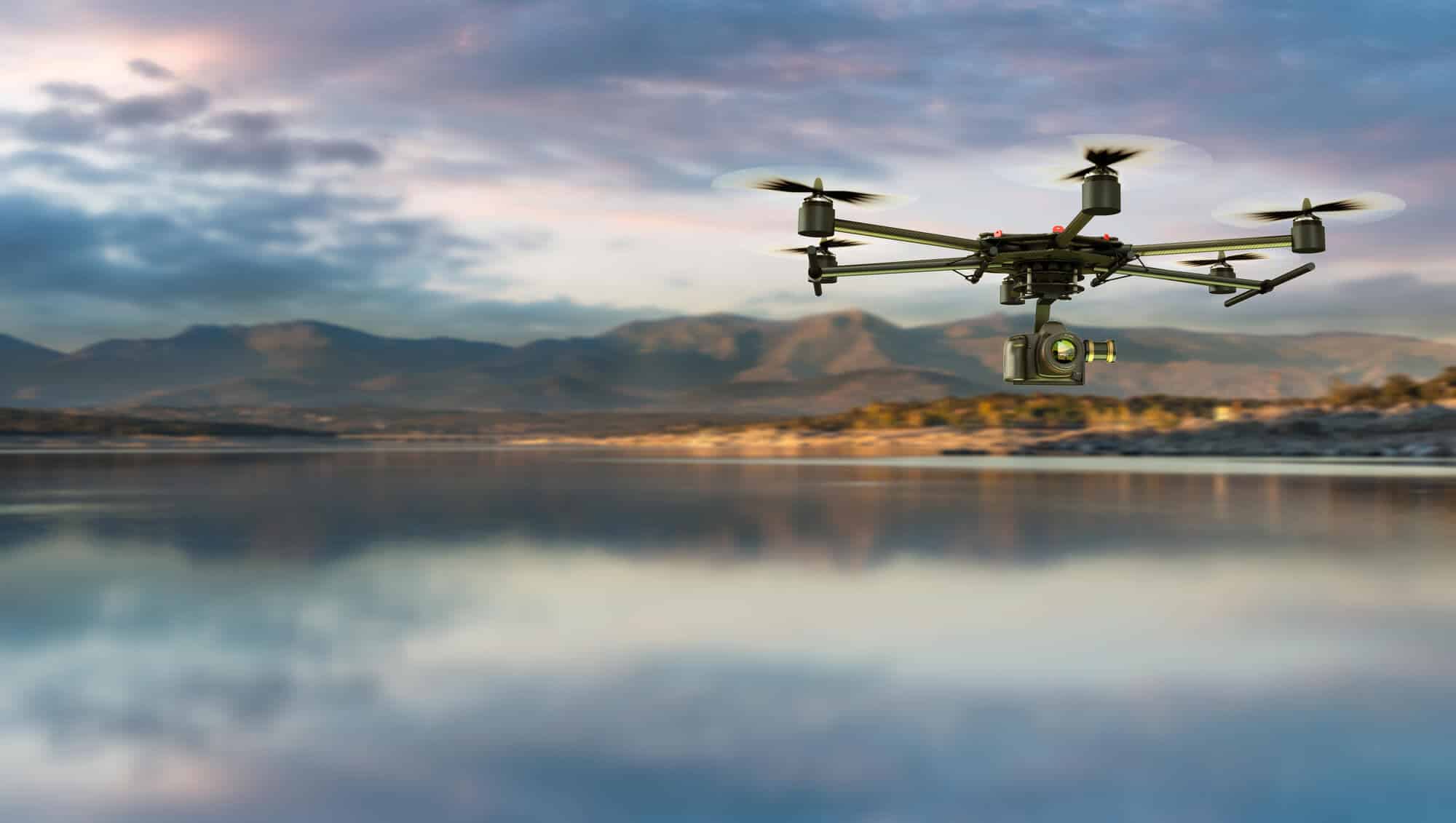
Commercial drone operations are covered by Title 14, Chapter I, Subchapter F, Part 107 of the Code of Federal Regulations. Part 107 is too long and complex to summarize in full here, but the gist of it is that you must get a remote pilot certificate. The test for this license must be taken in person, and is a lot more in-depth than the recreational exam — think of it like a driving test.
Once you’ve passed the test and completed Form 8710-13, you’ll have your license and be ready to commercially pilot a drone. Register your drone and mark it with its registration number in a clearly visible fashion (see the “recreational” section for tips).
Under Part 107, you need a waiver for some drone activities even if you’re fully licensed. These include flying:
- More than 400 feet above the ground;
- A drone from a moving vehicle;
- A drone at night without visibility lighting;
- Outside your visual line;
- Multiple drones at the same time;
- Over people or moving vehicles with a drone weighing more than 0.55 pounds or with potentially lacerating parts;
- In low visibility.
You can apply for a waiver on the FAA’s DroneZone website.
How to Get an Airspace Authorization
There’s a lot of uncontrolled airspace where you can freely fly your drone. However, in the rare cases where you can’t avoid flying in controlled airspace, you can get a waiver from the FAA.
You’ve got two options for this. The first is to go through the Low Altitude Authorization and Notification Capability (LAANC), a partnership that offers real-time approvals through a list of approved companies (scroll down on that page to find it).
Your other option is to go through the FAADroneZone, the same page where you registered your drone. This may be easier, but you can’t get the approval in real time.
State-Specific Drone Regulations
Some U.S. states add stricter drone regulations on top of the federal laws we’ve already gone over. Many states ban drones from their state parks in the same way national parks do; check your local drone laws if you aren’t sure. Here are a few of the most important state drone laws to know.
California
California’s Bill 856 is one of the main reasons I’m covering drone rules on a website about privacy. This law, signed in 2015, makes it illegal to fly a drone into someone’s airspace, so you can take photos of them doing something private. It slaps fines on any paparazzi who try to use UAVs to snap pictures of celebrities.
Several other states have similar laws protecting citizens against having their privacy invaded by another citizen’s drone. In Tennessee, it’s illegal to capture drone images of an outdoor event without permission from the owner of the venue.
According to the National Conference of State Legislatures database, 19 states currently have laws against using a UAV to violate someone’s privacy: Arkansas, California, Delaware, Florida, Idaho, Indiana, Kansas, Louisiana, Michigan, Minnesota, Mississippi, North Carolina, Oregon, Pennsylvania, South Dakota, Tennessee, Texas, Virginia and West Virginia.
Florida
A few states have also enacted laws that regulate the use of drones by law enforcement. One leading example is Florida’s SB 92, the Freedom from Unwarranted Surveillance Act. It requires police to get a warrant before spying on someone through a drone, with citizens able to sue if their rights aren’t respected.
Similar laws can be found in other states. Vermont specifically bans police from using drones equipped with facial recognition software. In all, 18 states limit the ability of police to obtain evidence with a UAV: Alaska, Florida, Hawaii, Idaho, Illinois, Indiana, Iowa, Maine, Montana, Nevada, North Carolina, North Dakota, Oregon, Tennessee, Utah, Vermont, Virginia and Wisconsin.
New Jersey
States have covered other niche cases with specific drone laws. Several make it illegal to use a drone for hunting (or bothering other hunters), and Utah includes protections for livestock.
However, I’d like to close by recognizing New Jersey, whose SB 3370 appears to contain the only direct ban on operating a drone while intoxicated. Under New Jersey law, you can be charged with drunk driving for flying a drone while your blood-alcohol level is above 0.08 — one of the few ways to get a DUI without being in a vehicle.
Before you hop across the border to New York for some drunk droning, remember that the FAA defines drones as civilian aircraft, which are already illegal to operate while drunk. New Jersey is just the first state to apply the penalty to UAVs in particular, but others are likely to follow.
Conclusion
Like the internet, drones are a new technology that’s only as good or bad as the choices we make about how to use it. Used responsibly, drones can save lives, make great art and provide hours of fun.
However, if left unchecked, drones can also be used to further erode our privacy rights. The fact that 18 states require a search warrant for evidence obtained by drone is a great start, but it means the other 32 are dropping the ball. I strongly encourage every American to call their legislators and ask what they’re doing to prevent UAV abuses by both regular citizens and law enforcement.
Are you a drone user? Think the laws are too strict, or they don’t go far enough? Let’s chat about it in the comments. Thanks for reading!

Leave a Reply